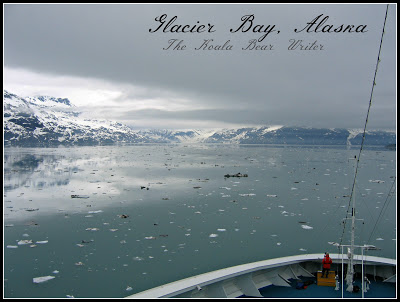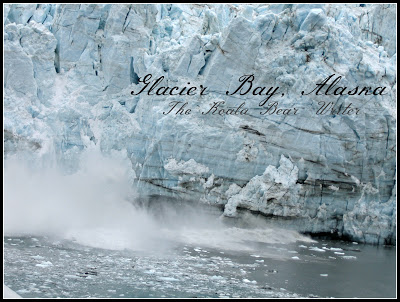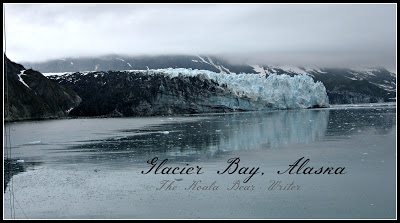Fog surrounds our ship as we glide forward into Glacier Bay. The ship’s horn sounds at regular intervals, making us jump as we lean on the railing, hoping for the fog to lift. Cold presses in upon us, making us turn up the collars of our coat and wish we’d packed for winter rather than late May. Even in mid-winter, the Bay won’t freeze over; wind, tide and “moderate maritime temperatures” keep the water open year-round.

It is 2007, and my husband and I are on an Alaskan cruise for our honeymoon. We set sail from Vancouver, BC, named for Captain George Vancouver, who explored Glacier Bay in 1794. He described it as a “sheet of ice as far as the eye could distinguish.” When naturalist John Muir arrived nearly a century later to visit a group of native Tlingits who call the Bay home, the ice had already began retreating. Glacier Bay is now “one of the world’s most majestic wildernesses” and Muir’s poetic descriptions of the park continue to inspire visitors.

Even when the fog lifts, as we venture further into the Bay, the clouds hang low over the water. Ice bergs of all sizes dot the ocean around the boat. The mountains are monoliths of stone and ice. This seems like a forbidding, hostile place, yet it is home to a variety of wildlife. Bald eagles and puffins make nests here while otters, seals and humpback whales inhabit the water. If we had binoculars, we might have scanned the shores for brown bears, moose or mountain goats. On this cold, foggy spring day, the only wildlife we see are a few seagulls floating on the ice bergs about our boat.

The highlight of our visit to Glacier Bay is watching the glacier calve. It seems everyone is on the deck of the ship, fighting for a space at the railing as we stare at the glacier, waiting for a piece of ice to break free and join the bergs floating in the water. A cheer goes up when the glacier calves and we saw it several times, but I only have one picture of it happening—calving is a quick moment, just a rumble of ice and a puff snow and then another ice berg bobs away from the glacier. Although not much seems to be happening here, the glacier is actually moving over five feet per day and calving occurs several times an hour.

Most glaciers are found high in the mountains. The glaciers we see in Glacier Bay are tidewater glaciers, unique because they reach from the mountains right down to the ocean. Calving happens when water undermines the ice at the front of the glacier, making it break away into the ocean. The Bay itself was carved by glaciers and is over 1,000 feet deep in many places. The glaciers we see on our cruise of the Bay are really just a small part of the ice in the park.

Glacier Bay is the setting for Tricia Goyer and Ocieanna Fleiss’ new novel Love Finds You in Glacier Bay, Alaska. Ginny Marshall is on the verge of making her singing dreams come true when she decides to ask her ex-fiance Brett for advice. Doing that takes her to the town of Glacier Bay, Alaska, where she discovers a box of old love letters. As Ginny is reunited with Brett, she may find more than just advice!
Quotes and facts about Glacier Bay are taken from a Princess Cruises brochure and a map/guide to Glacier Bay. All opinions expressed are my own. I’m part of Tricia Goyer’s 2013 Book Launch Team.

11 Comments
What an awesome review and to experience it first hand. Wonderful! I’m gonna share your blog review, pics, etc….
Tina ‘the book lady’
This is my first visit to your blog and I just loved the incredible pictures. What a lovely honeymoon.
Bless you
Mia
Your photos are amazing!! What a majestic place! I would love to visit Alaska. Thanks for sharing your experience and pictures 🙂 The book you write about sounds good, I may have to find that one! Stopping by from Mindy’s link-up, have a blessed day!!
Those pictures are stunning. What a great way to share your story. Thanks for letting me know about the book…I’ll have to gave a read…I love books.
So pretty. Is it true that the trip is all “grey hairs” lol.
I have always wanted to visit Alaska, just seeing these pictures makes me wanna go. Makes hubby feel cold but there is such beauty in Alaska that it needs to be seen and experienced. 🙂
What an awesome honeymoon trip! Thanks for sharing your images from it.
Beautiful!! I want to go to Alaska one day. As a geographer, glaciers fascinate me!
Beautiful pics! After reading your post it makes me want to venture there some day!
Alaska is so beautiful. I really hope I can visit there some day.
Such wonderful photos!
I enjoyed reading your post about this book, Im currently reading it and love it! =)